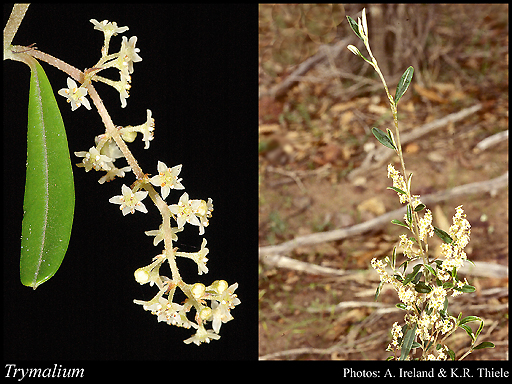- Reference
- Enum.Pl. p20 (1837)
- Name Status
- Current

Scientific Description
Common name. Trymaliums. Family Rhamnaceae.
Habit and leaf form. Shrubs, or trees. ‘Normal’ plants. Leaves well developed. Plants with roots; non-succulent; unarmed; autotrophic. To 5 m high. Self supporting. Not heterophyllous. Leaves minute (T. elachophyllum), or small to medium-sized; not fasciculate; alternate; with blades; petiolate, or subsessile; with ‘normal’ orientation; simple; not peltate. Leaf blades entire; flat, or folded (lengthwise to almost hide the lower surface), or solid; semi-terete; linear, or ovate, or obovate, or oblong, or elliptic; pinnately veined. Mature leaf blades adaxially glabrous, or pubescent (sparsely); abaxially glabrous, or pubescent (white hairy, or white stellate-hairy). Leaves with stipules. Stipules scaly; persistent. Leaf blade margins entire; flat, or revolute. Leaf anatomy. Hairs present, or absent; complex hairs present, or absent. Complex hairs stellate.
Reproductive type, pollination. Fertile flowers hermaphrodite. Unisexual flowers absent. Plants hermaphrodite.
Inflorescence and flower features. Flowers aggregated in ‘inflorescences’. Inflorescence many-flowered, or few-flowered. Flowers in cymes, or in racemes. Inflorescences compound. The terminal inflorescence unit cymose. Inflorescences terminal, or axillary. Flowers pedicellate; bracteate. Bracts deciduous (usually), or persistent. Flowers minute; regular; 5 merous; cyclic; tetracyclic. Free hypanthium present. Perianth with distinct calyx and corolla; 10; 2 -whorled; isomerous. Calyx present; 5; 1 -whorled; gamosepalous; lobed. Calyx lobes divided to the disk. Calyx glabrous; valvate; regular. Calyx lobes ovate. Epicalyx absent. Corolla present; 5; 1 -whorled; alternating with the calyx; polypetalous; regular. Petals hooded (but not always enclosing the anthers). Corolla members entire, or fringed (3-lobed, T. angustifolium). Androecium present. Fertile stamens present. Androecial members definite in number. Androecium 5. Androecial members adnate (inserted near the disc); free of the gynoecium; free of one another; 1 -whorled. Stamens 5; all more or less similar in shape; isomerous with the perianth; alternisepalous; filantherous. Anthers separate from one another; dehiscing via longitudinal slits; bilocular; tetrasporangiate. Fertile gynoecium present. Gynoecium 3 carpelled. The pistil 1 celled. Carpels reduced in number relative to the perianth. Gynoecium syncarpous; synstylovarious; inferior, or partly inferior. Ovary plurilocular; 3 locular. Gynoecium stylate. Styles 1; apical. Stigmas 2–3 - lobed. Ovules 1 per locule (in WA); ascending; anatropous.
Fruit and seed features. Fruit aerial; 1–3 mm long; a schizocarp. Dispersal unit the seed, or the fruit. Seeds 1 per locule.
Geography, cytology, number of species. Native of Australia. Endemic to Australia. Australian states and territories: Western Australia, South Australia, Queensland, and Victoria. Northern Botanical Province and South-West Botanical Province. A genus of ca 11 species; 8 species in Western Australia; 8 endemic to Western Australia.
Etymology. From the Greek for "the eye of a needle"; refers to the three slits at the summit of the fruit when it opens.